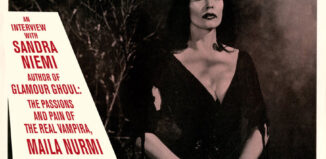Mailable Motorcycle Art:
Two-Wheeled Postcards from Around the World
Story & Photos by Paul Garson

Redlands, California 1900
Postcards were utilized as means of advertising more than a hundred years ago as demonstrated by his example printed by a California shop offering both bicycles and motorcycles.
Before there was Twitter and text messaging there were postcards. Tons of them. In fact, many millions have been posted from almost every country in the world, the appearance of postcards stretching back more than 150 years. While there’s no special term for collecting motorcycles, postcard collecting and their research has one… Deltiology. And at last count it happens to be the third largest collecting hobby in the world, next to coin and stamp collecting.
Naturally when you have postcards you have the postal stamp. The first, known as the Penny Black, was printed by England in 1840 while privately produced postcards that included images first appeared in Austria in 1869 and the die was cast, the phenomena of illustrated postcard skyrocketing in popularity around the world. The first colored postcard was introduced in 1889 while images of the newly erected Eiffel Tower helped to greatly expand interest in postcards. The first cards showing real photographs began appearing in 1900.
In 1906 postcards benefited from another boost with the appearance of the Eastman Kodak foldable camera, amateur photographing booming and the resulting images transferable to postcards. In 1908 the U.S. population was listed at 88,700,000. In that same year, some 678,000,000 postcards were mailed within and from America. The era was called the Golden Age of postcards, but that all faded a bit with the advent and spread of the telephone as a means of rapid communication, but then the introduction of color postcards bumped it back up. The advent of the Internet and today’s electronic cards have had an impact, but postcards, recognized as an art form unto itself, still remain popular, especially with collectors who have nearly 150 years of postcards to choose from and a bunch of them motorcycle related including the following.
As a motorcyclist of some 40 years, I focused on postcards with images that spoke (or bespoked) to me over the years, some of which follow…no stamps needed.

1908 – Embossed Postcard – Made in Germany – Mailed in the U.S.
This special embossed color postcard was postmarked from Cuba, Missouri at 5:00 PM Sept. 7, 1908 by a person who signed her name Jannine to a Miss Edith Barker of Millers Falls, Massachusetts. The depiction of a wicker sidecar is accurate as many similar “chairs” were built to carry family and cargo. As for the “P F” on the gas tank, no reference could be found to link it to a real motorcycle made in Germany or the U.S. and its may the initials of the artist. The card itself was apparently printed in several different languages and sold internationally.
1910 – 86, 414 British bike riders have registered their machines. By this year 31 U.S. motorcycle companies are in still in production, although several have fallen by the wayside
1913 – Bike registrations in England have jumped to 180,000, nearly a 100,000 added in the previous three years.

1914 – WWI French Postcard – “Missed!”
The caption in both French and English relates to a motorcycle courier outrunning
German sentry’s rifle shots as he speeds on his mission through enemy lines. The artist’s name is listed…de Carrey apparently excerpted from another work titled “The Mirror.”
France is rich with its own motorcycle history with literally hundreds of manufacturers, most of whom have come and gone, but many leaving exceptional machines. One famous mark was the Gnome et Rhône originally known for their aircraft engines. During WWI, some 100,00 of their 9-cylinder Delta and Le Rhône 110 hp rotary designs powering the majority of all aircraft in the early years of the war. Even larger engines powered WWII aircraft. In 1920 they introduced their first motorcycle, the Gnome et Rhône 500 cc while various other models were produced up to the early 1950s,

World War One French Postcard – On Leave a Soldier delivers flowers to his ladyfriend via his Rene Gillet. Tank on rear may be extra fuel or gas for the headlamp. The R G’s first appeared 1897, V-twins by 1904, eventually the side-valve 750 and 1000cc machines popular with the French army.

1915 – WWI U.S. Army Motorcycle Sidecar Mounted Machinegun Trooper
While the iconic Harley-Davidson first appeared in 1903, the company began supplying the U.S. military in 1915, it solo mount and sidecar machines gaining experience during 1916 when some 20,000 U.S. troops under the command of General John “Black Jack” Pershing were granted permission by the Mexican government to enter their country in pursuit of the bandit/revolutionary Pancho Villa. While they never caught up with him, even with their Harley and Indian motorcycles that could go where heavier vehicles could not, the American army learned valuable lessons including those concerning the new “Motor Mobile Infantry” and “Mounted Infantry.” Oddly enough their quarry, Pancho Villa, was an avid motorcyclist himself, preferring the Indian.
1915 – U.S. motorcycle registrations had skyrocket to an estimated 180,000. But by the 1932, of over 300 total original builders, only two will have survived: Indian and Harley-Davidson.

1917 – “Motor Cycle Scouts in Action”
The colorized postcard dated Dec. 6, 1917 was sent from Greenville, South Carolina, site of a U.S. military training camp. While the driver of the sidecar rig ducks for cover, the rifleman aims his Springfield carbine at some imaginary enemy for this posed photo.
***
When the U.S. finally entered the war in 1917, Indian gave its entire production to the military, almost bankrupting itself, selling them at cost and leaving civilian showrooms bare. Harley took a different strategy, providing 50% of its production, the rest going to the public. The Harleys, powered by 1000cc v-twin engines produced 15hp. The factory prospered, many bikes also going to the Dutch and Russian military including gun and stretcher carrying models. Harley-Davidson supplied about one third of the 70,000 machines ordered by the U.S. military, the remaining two-thirds divided between Indian and Cleveland. Of the 26,486 Harleys bought by the U.S., some 7,000 going to England and France where they served as convoy escorts, dispatch, scouting and reconnaissance vehicles.

Henderson Four Goes Hill-Climbing – Original Photo Postcard – Apparently a Model F circa 1913-17

Three Up on a 1927 Böhmerland Attire – Original Czech Postcard
Various models of the Böhmerland were built from 1934 until 1939 in Czechoslovakia. So where did it get its “styling” cues? Well, literally out of thin Czech air. Seems the builder, one Albin Hugo Leibisch started with a clean sheet to draw up his vision of the ultimate road bike, one that could carry up to four passengers. Rear “rockets” actually house the fuel. The 37 cubic inch engine specs include bore and stroke of 78 mm × 120 mm (3.1 in × 4.7 in.), good enough to pump out 16-20 HP.
While our side of Iron Curtain called it the Böhmerlander (Böhme related to the name of Bohemia, part of then Czechoslovakia), back in its home country it was known as the Cechie. The factory was located in the Czech city of Krasna Lipa aka known as Schonlinde since it was in German speaking area of the country “absorbed” in October 1938 by Germany. Some 3,000 bikes were built, however few surviving to the present.

1940 – Finland – Love at First Bike
A rider appears well-attired for motorcycling complete with goggles, gloves and helmet although his passenger sits in a less secure side-saddle position minus any protective gear. The colorized postcard was dated June 7, 1940 and sent from the city of Turku, the oldest settlement in Finland, and located in southwest coast of country at the mouth of the Aura River. In 1996 Turku was declared the official Christmas City of Finland, then designated the European Capital of Culture for 2011.
Only a couple motorcycle references to Finnish motorcycles could be found and one happened to be made in none other than Turku, the company being Tunturi, its history beginning in 1922 and leading to successful bicycle production. In the 1950s the Tunturi led the Finnish domestic market leader in mopeds. They are best known in foreign markets for their range of physical fitness equipment development including stationary bicycles now sold in 40 countries.
The other Finnish manufacturer was Helkama Oy best known for its bicycles (Helkama Velox), and also for umbrellas, cables for ships and communications, household appliances and some car parts. During the 1970s and 1980s a Helkama trial bike won several trial races. The company also made several mopeds that were very popular in Sweden until production ceased in the 1990s.
***

1941 – U.S. – Harley-Davidson and Thompson .45 Machinegun
As early as 1937 the U.S. military visited the Harley-Davidson factory intent on finding a suitable motorcycle for the war they saw as inevitable. Toward that end the Milwaukee company sent the head of its factory service school on a cross country tour of every Army camp east of the Mississippi, logging 200,000 miles on his Harley EL “Knucklehead.”
By 1939, the Army had compared various Harleys and Indians as well as a BMW clone produced by the Delco Corporation. It chose Harley-Davidson, but required that it could reach 65 mph, be able to ford streams 16 inches deep and not overheat at slow speeds slogging through muddy fields.
***

1953 – England – Triumph Thunderbird 650cc – “The Best Motorcycle in the World” An illustration from the Triumph factory’s 1953 catalog appears on a commercial postcard.
The previous 500cc vertical twin Triumph powerplant was bored out to 650cc to appeal to the power hungry American market. Designated as the 6T Thunderbird, the name conjured up the Triumph’s stellar engineer Edward Turner during a visit to the U.S. The new model was debuted in Paris at the Monthery racecourse where three factory riders average 92mph over 500 miles after the riders had ridden from the factory in England to the track and then back again, providing some high profile press for the new machines which was further enhanced when Marlon Brando rode a 1950 Thunderbird in the “The Wild One” in 1953, although the conservative owners of Triumph officially objected to their machine appearing in a rowdy biker movie. However they did not complain about the big jump in Triumph sales that followed the release of the film. The last Thunderbirds were made for English consumption in 1966 by which time the even more famous Bonneville had taken center stage.

1961 – England – Norton Manxman – Mayfair Cards of London – Courtesy of Norton Motors, Ltd.
The caption on the reverse of the card reads: “Every feature of the 1961 Norton was a direct development of Grand Prix racing. It was the know-how gained from winning races all over the world which gives a Norton bike race-bred performance which is second to none. By 1961 the Norton had won 32 T.T. races.”
The Manxman derived its name from the famous Isle of Mann race course, the island also home to the famous tail-less Manx cat. Norton also built the famous Manx single cylinder racers that earned the company so many victories. On November 7, 1960 the first new 650cc Norton Manxman with the vaunted Featherbed frame was launched for the American market only. It was later followed by the larger displacement 750cc Norton Atlas in April 1962 because of the American market demand for more power. However the Atlas proved too expensive to build, profits meager and the cause of growing financial problems for the company. Fortunately in 1968 the new Commando appeared to save the day, at least temporarily.

1970s – U.S. – “The Coke Machine”
An example of a limited production privately produced postcard shows the creation of Angela Johnston and David Cargill of Des Moines, Iowa. The 1948 Harley-Davidson Panhead’s 74 cu. in. motor was pumped up to run the quarter mile in 12.09 seconds at 120 mph. The caption on the reverse reads, “A metal sculpture. A kinetic array of Coca-Cola nostalgia. A collage of advertising. Certainly, things go better aboard a customized Harley.”
***
BIO
Paul Garson is an American writer and photographer who lives and writes in Los Angeles in a small apartment with an old rug and a loyal cat. He has written nonfiction articles—many with his own photography—for over 70 US and international publications as well as written a dozen nonfiction books. He has high hopes of being a space tourist or at least getting to Iceland before it turns into Hawaii.



















